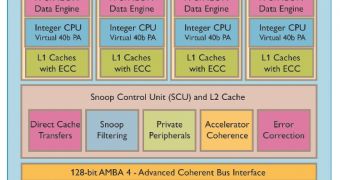Although ARM seems to be determined to make a strong entrance into the desktop and server CPU market, the company has no immediate plans to add 64-bit instructions to its processor architecture, choosing instead to rely on the 40-bit addressing built inside their Cortex-A15 core.
“Some applications which run on service rely on 64 bit. Some rely on 40-bit addressing and that is built into Cortex-A15. Whilst Cortex-A15 is a 32-bit processor, it has the extended addressing.
“There are certainly server applications today for which 64-bit or lack of 64-bit is not a barrier,” said Warren East, chief executive officer of ARM.
“We are not in the business of announcing our 64-bit products today. But it’s logical to suppose that at some stage in the future, ARM will extend its architecture in that direction,” continued the company's representative.
64-bit addressing is particularly important for servers, as such systems require to access more than the 4GB of memory allowed by 32-bit processors as well as a wider range of I/O connections than what ARM's architecture can muster at this time.
In addition, all the server CPUs that are available right now come with 64-bit support, making ARM the only player in this race that is limited to 32-bit.
The so-called Large Physical Address Extension, which is built inside the Cortex A15 architecture, is a step in the right direction as it allows for up to 1TB of memory to be accessed, but it still has limitations and doesn't offer too much of a headroom for the architecture to grow.
ARM has recently announced it plans to gain a share out of the desktop and server processor markets by 2015, as the company sees this space as a huge opportunity for it, especially considering that Microsoft announced the upcoming Windows 8 OS will be compatible with the ARM architecture. (via X-bit Labs)

 14 DAY TRIAL //
14 DAY TRIAL //